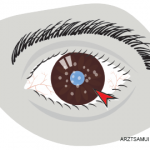A positive clinical response, with improved intraocular inflammation and reduced anterior chamber cell reaction, was noticeable around the fourth month after the first infusion. At the final follow-up visit, all eight patients reached complete control of uveitis. In two patients, uveitis was controlled, but rituximab lacked efficacy in treating arthritis, so they were switched to golimumab.
All patients tolerated the drug well. None experienced side effects or rituximab-related complications during the follow up. By the end of follow up, systemic corticosteroids and immunosuppressants used with rituximab were discontinued in five patients.
Dr. Forrester said, “In severe cases, the standard treatment, methotrexate, may help the joint symptoms but does not control the eye inflammation. Recent studies have shown that the newer biologic agents, particularly therapies that block the inflammatory protein TNF-alpha, have revolutionized the management of these patients, and that treatment early in the course of the disease is probably best.”
Dr. Vinit B. Mahajan, assistant professor of ophthalmology and visual sciences at the University of Iowa in Iowa City, told Reuters Health by email, “There are many immunosuppressive medications available that were originally developed for immune diseases not affecting the eye. We don’t know which ones will also work for the eye and for how long, so these findings are exciting.”
“They are very important, since there are children all over the world who may not respond to conventional therapy,” added Dr. Mahajan, who was not involved in the study. “This study suggests an important alternative that may help prevent blindness and gives us an idea that in selected patients, rituximab can be effective for several years.”
The authors advised that their results should be interpreted with caution due to the study’s retrospective design, low number and heterogeneity of patients, and lack of a control group. Drs. Forrester and Mahajan agreed with the authors that further prospective randomized trials of rituximab are needed in larger groups of patients to better evaluate its efficacy, dosing regimen, and safety.
The corresponding author declined to comment.


